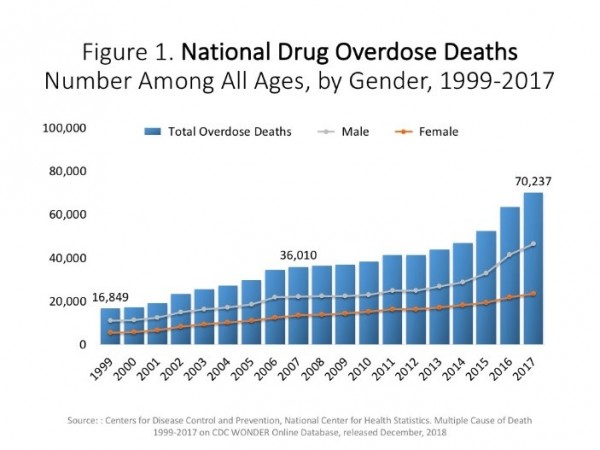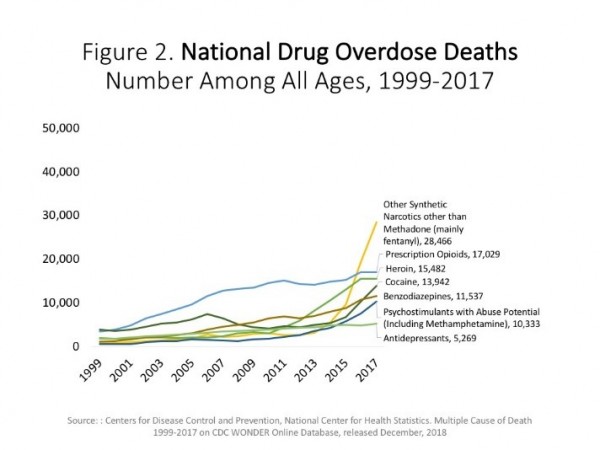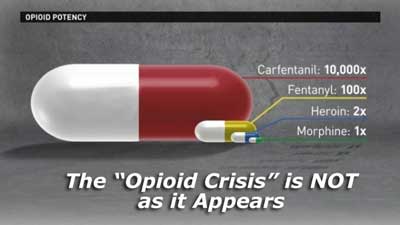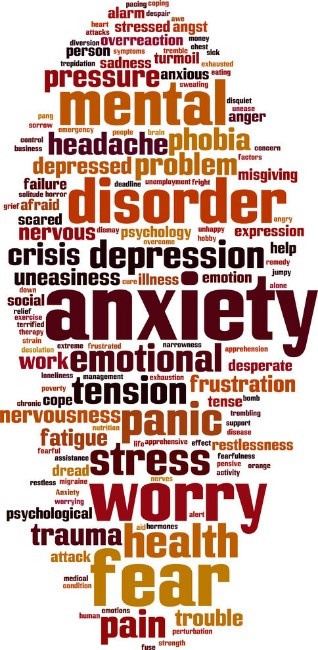The “Opioid Crisis” is not as it Appears
The public has been misled by irresponsible actions
“What we have here is a failure to communicate”. That’s a great line from the 1967 movie Cool Hand Luke. It is meaningful today as well. The entire "opioid crisis/epidemic" has been a failed communication from many different directions. There are numerous reasons why the entire CDC Guidelines must be completely rescinded, struck from the records. They have cost the lives of good people trying to live with chronic pain. Also, they have put hundreds of thousands, if not millions, of Americans' health at risk.
So let us look at some statistical reasons why the CDC Guidelines was a failed document before it was even released.
We have been deep in what originally was called an "opioid epidemic" and now is being called an "opioid crisis." It certainly sounds like a just cause, and it is all the talk around the water cooler unless there are sports to talk about. What do we really know about this supposed “opioid crisis” anyway? Why was it changed from being an "opioid epidemic" to an "opioid crisis?"
We firmly believe opioids are evil because we are being told this. The problem is that singularly using the word opioid paints an incomplete picture of reality. What is an opioid? Most often when one hears the word opioid they think about illegal drugs. Opioids are strong medications which produce morphine-like effects. In medical care, they are primarily used for pain relief including anesthesia. Opioids include highly beneficial pain management medications which hundreds of thousands of responsible American’s are prescribed so they may have some quality of life. Opioids are not just illegal drugs being sold in back alleys, or in broad daylight in some neighborhoods. Also, they are not drugs which people can become "addicted" to easily. Even the word "drug" covers an extremely broad range of items. Used alone it can be difficult to understand what is being discussed. In today's world, people are so rushed that they don't take time to fully understand.
Let’s look at some numbers, statistics, mathematicians’ friends. Many who set policy and look to govern others like working with statistics because they are cold numbers without faces. It is easier for them to orchestrate public changes without considering the effects their actions have on others. They do not open their minds to who the numbers represent, often because it might adversely affect their work. Cold numbers for cold public policy, which hurts more often than helps.
 However, we need to remember that these numbers represent adult lives (I say "adult lives" because adult statistics are readily available). These adult lives are mothers and fathers, daughters and sons, grandparents, cousins, aunts and uncles. They are friends and co-workers. These are lives we interact with, and I hope you would agree that they deserve to have the best possible quality of life available to them.
However, we need to remember that these numbers represent adult lives (I say "adult lives" because adult statistics are readily available). These adult lives are mothers and fathers, daughters and sons, grandparents, cousins, aunts and uncles. They are friends and co-workers. These are lives we interact with, and I hope you would agree that they deserve to have the best possible quality of life available to them.
Did you know…
The 2018 American population, as per the U.S. Census Bureau, was 327,167,434 of which 253,881,838 were 18 and older, adults (1). This number is being shared as a reference point. We need to gain an understanding of the people we come in contact with on a daily basis. Many people are fighting battles we know nothing about. Chronic pain most often is invisible much like mental health conditions. In addition, most often mental health conditions can accompany chronic pain. We are unable to know just by looking at someone what they may be facing on a day-to-day basis. However, we can gain an understanding and appreciation for what others might be facing.
For those without health problems, it is even more important. First, so you appreciate how fortunate you are to have good health. Secondly, because the reality is each person is one accident, one misstep, or one illness away from a life of living with chronic pain. That is not cheerful news, it is real though. We all should learn to appreciate life as we know it.
Keep in mind that both chronic pain and mental health carry heavy stigmas from society. Since they are not easily seen they are looked down upon.
54.4 million
“The aches and pains of arthritis — caused by inflammation in one or more joints — afflict 1 in 4 American adults, or 54.4 million people, according to a new report from the Centers for Disease Control and Prevention” (2). This was reported in a Washington Post article: “The Big Number: 54.4 million adult Americans suffer arthritis” By Linda Searing on June 23, 2019 (3).
Many people know someone who sufferers from arthritis. Arthritis is a chronic pain condition, and often is just one piece of the overall health conditions the person lives with. I am bringing this number into the statistics I will use to show why the “opioid crisis” unjustly targets responsible Americans fighting for an oftentimes basic quality of life. For many, it is less than that. These are people who wished they did not need to take medications. Yet, the medications they need are being wrongly reduced and/or eliminated. They are not addicted and they are not drug users. They are victims of an irresponsible government document, poorly utilized, which has grouped opioids into one large category.
 The additional numbers we will be looking at are from the 2017 National Institute on Drug Abuse - Overdose Death Rates (4).
The additional numbers we will be looking at are from the 2017 National Institute on Drug Abuse - Overdose Death Rates (4).
- National Drug Overdose Deaths: 70,237 from drug overdoses, this number includes all drugs.
- National Drug Overdose Deaths: 17,029 involving prescription opioids. No distinction was made between properly used prescription opioids and those which were illicitly obtained and used. This is not a clear picture as to the actual deaths linked only to prescription opioid overdoses. This appears to be the closest statistic.
- National Overdose Deaths Involving Any Opioid: (combines all opioid drugs) 47,600. This covers deaths which multiple opioids were found in the deceased. It is a number we have often heard, yet it combines numerous opioids and does not provide a clear picture.
Doing some math – Arthritis related
If we only take the above number, 54.4 million adult arthritis sufferers, and look at the percentage of opioid-related deaths we find more data which should be used in the case against the "opioid crisis" and its irresponsible attack on pain patients.
 Using 54.4 million adults living with arthritis we find the following:
Using 54.4 million adults living with arthritis we find the following:
- 17,029 overdoses involving prescription opioids = .0313%
- Resulting in 54,382,971 adult arthritis sufferers are unjustly targeted
- 47,600 overdoes involving any opioid = .0875%
- Here we find 54,352,400 adult arthritis sufferers are unjustly targeted
- 70,237 drug overdoses (all drugs) = .1291%
- Finally, here we have 54,329,763 adult arthritis sufferers are unjustly targeted
To put those results in a different perspective, those are 1,080,000 adults per state. People trying to live their lives.
Now for the truly big number
An estimated 126 million adults reported some type of pain in the 3 months prior to a new analysis of data from the 2012 National Health Interview Survey (NHIS) which was released on August 11, 2015. The report titled “NIH analysis shows Americans are in pain” has found that most American adults have experienced some level of pain, from brief to more lasting pain, and from relatively minor to more severe pain (5).
Yet there are some 126 million adult pain sufferers or approximately one-third of the American population. Now when we factor in this number the results are even smaller:
- 17,029 overdoses due to prescription opioids = .0135%
- Resulting in 125,982,971 adults living with pain are unjustly targetted
- 70,237 drug overdoses (all drugs) = .0557%
- Here we find 125,929,763 adults living with pain are unjustly targetted
Now we are looking at 2,500,000 adults per state trying to live their life.
A further view of these results to make the world feel smaller:
Adults living with arthritis (54,400,000) is 16.74% of the American population or approximately 1 in 6 adults.
Adults living with some form of chronic pain (126,000,000) is 38.77% or approximately 1 in 3 adults.
 As I mentioned earlier, it is impossible to know what someone might be living with just by looking at them. Another major challenge for people living with chronic pain is flareups. We may be looking fine, appearing to be healthy, but then a flareup hits and we can either be slowed down or completely down. If someone does not understand living with chronic pain, they might think we are pretending to be in pain. Again, the invisibility of chronic pain and mental health creates many societal problems. These need not exist if there was some compassion.
As I mentioned earlier, it is impossible to know what someone might be living with just by looking at them. Another major challenge for people living with chronic pain is flareups. We may be looking fine, appearing to be healthy, but then a flareup hits and we can either be slowed down or completely down. If someone does not understand living with chronic pain, they might think we are pretending to be in pain. Again, the invisibility of chronic pain and mental health creates many societal problems. These need not exist if there was some compassion.
The following graph is from “Drug War Facts” which is a project of Common Sense for Drug Policy (6). The data shows there are many drug-induced deaths in America, which is very unfortunate. From there it does break down by several specific additional drugs leading to the deaths. It is interesting to note that they cite “Overdose Deaths Involving Any Opioid” yet they fail to separate out prescription opioids as a singular cause. Why won’t they provide such necessary information? It appears relatively easy to break down the numbers to other specific drugs which were involved in the deaths.
| 2016 Data Detailing Drug-Induced Deaths, Breaking Out Specific Data for Natural and Semi-Synthetic Opioids (including Oxycodone), Synthetic Opioids (including Fentanyl), and Heroin, as Reported by the CDC
|
|
| Total Deaths Attributed to Drug Overdose | 63,632 |
| Overdose Deaths Involving Any Opioid | 42,249 |
| Overdose Deaths Involving Heroin | 15,469 |
| Overdose Deaths Involving Natural and Semi-Synthetic Opioids | 14,487 |
| Overdose Deaths Involving Methadone | 3,373 |
| Overdose Deaths Involving Synthetic Opioids Other Than Methadone | 19,413 |
As for myself, I have lived with chronic pain for over three decades and the scope of the opioid crisis is very concerning to me. Currently, I am doing well without prescription pain medications. In 2013, I was up to 60mg of Oxycontin twice a day, plus Oxycodone for break-through pain, as well as a muscle relaxer, anti-inflammatory, and an anti-depressant. I hope to never need prescription pain medications again, yet it might occur. The current state of misleading information makes that prospect even scarier.
The word “opioid” is a general term for numerous drugs ranging from legally prescribed medications to illegally made and distributed drugs. To use that single word on its own is completely irresponsible. The word must be required to include which "opioid drug" is being discussed. Even the word “drug” is much too general a description, yet we use it constantly.
 Another misused word is “fentanyl”. There is prescription fentanyl which is an extremely powerful pain medication. When properly prescribed and used the patient receives pain relief. Then there is illegally manufactured fentanyl. It comes in many forms and the one most often mentioned is “carfentanil”, the most dangerous of all. It is used to sedate large animals, for example, elephants for surgery. Yet, time and time again carfentanil is referred to only as fentanyl. Please see the image "Opioid Potency" to gain an understanding of these differences.
Another misused word is “fentanyl”. There is prescription fentanyl which is an extremely powerful pain medication. When properly prescribed and used the patient receives pain relief. Then there is illegally manufactured fentanyl. It comes in many forms and the one most often mentioned is “carfentanil”, the most dangerous of all. It is used to sedate large animals, for example, elephants for surgery. Yet, time and time again carfentanil is referred to only as fentanyl. Please see the image "Opioid Potency" to gain an understanding of these differences.
These are the several commonly misused words within the opioid crisis. It is unfair to the public, who is not familiar with the information, to improperly use words. This has greatly added to the problem created by the poorly drafted CDC Guidelines themselves. It has become a game of playing telephone. You begin by telling something to the person next to you. They then pass it along to the next person and on the game goes. With each retelling the original information changes. Something might become forgotten or misunderstood. By the time the information goes around the circle things have changed. While this is human nature in a game, in the real world of chronic pain lives are at risk. It is paramount that correct terminology is used across all outlets. When you hear the following words, remember that they cover many different items: Opioid(s), Drug(s), Fentanyl.
“Overdose Deaths Involving Any Opioid” is misleading information which has helped fuel the opioid crisis. There are numerous "opioids" used to provide pain relief. Hundreds of thousands of people responsibly use to them to obtain the best quality of life possible. There appear to be more than six different types of "fentanyl". They range from prescription pain medication to carfentanil (elephant fentanyl).
Using one word to cover them all would be similar to saying "cars" or "cell phones" for example.
Yours in Hope,
Jory Pradjinski
Sources:
1. United States Census Bureau – Quick Facts
https://www.census.gov/quickfacts/fact/table/US/PST045218
2. State-Specific Severe Joint Pain and Physical Inactivity Among Adults with Arthritis — the United States, 2017. May 3, 2019
https://www.cdc.gov/mmwr/volumes/68/wr/mm6817a2.htm?s_cid=mm6817a2_e
3. Washington Post “The Big Number: 54.4 million adult Americans suffer arthritis” By Linda Searing on June 23, 2019
4. NIH: National Institute on Drug Abuse. Overdose Death Rates, Revised January 2019
https://www.drugabuse.gov/related-topics/trends-statistics/overdose-death-rates
5. National Institutes of Health; Tuesday, August 11, 2015 “NIH analysis shows Americans are in pain”
The report examines the prevalence, severity, and duration of pain.
https://www.nih.gov/news-events/news-releases/nih-analysis-shows-americans-are-pain
6. Drug War Facts, a project of Common Sense for Drug Policy
Hedegaard H, Warner M, Miniño AM. Drug overdose deaths in the United States, 1999–2016. NCHS Data Brief, no 294. Hyattsville, MD: National Center for Health Statistics. 2017.
https://drugwarfacts.org/node/3828
<<-- Back to Renewed Living Blog Email to a friend

